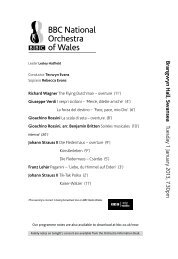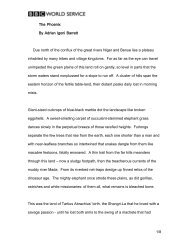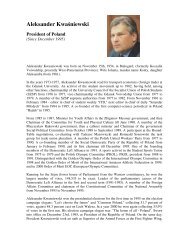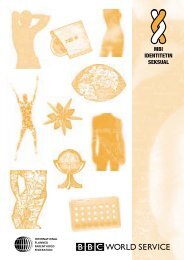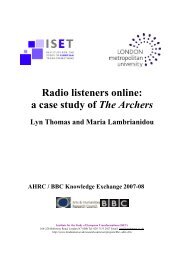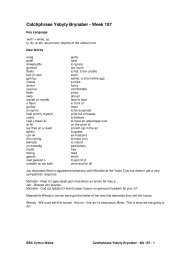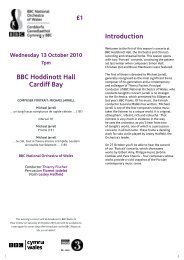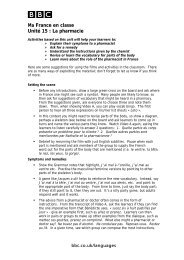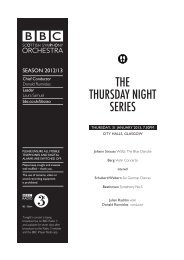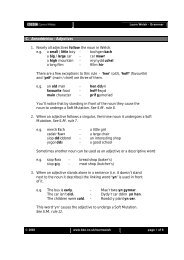musical traditions - BBC
musical traditions - BBC
musical traditions - BBC
You also want an ePaper? Increase the reach of your titles
YUMPU automatically turns print PDFs into web optimized ePapers that Google loves.
B B C Northern Ireland Learning <strong>musical</strong> <strong>traditions</strong> The Pipe Band<br />
teacher's notes<br />
refers only to the actual competition itself. The content of the performance is the highly developed<br />
art form, taking years to achieve competition standard and therefore demanding a high degree of<br />
commitment.<br />
Background<br />
Pipe bands may be seen as a relatively new phenomenon as distinct from the bagpipe itself<br />
(which has no clear origin, being found in countries throughout the world for thousands of years)<br />
and perhaps not particularly Scottish, having developed from the formation of army bands around<br />
the end of the 18 th century. At that time the British Army boasted twenty-two pipe bands made up<br />
from eleven Highland Regiments, one from each of their home and away battalions. Two centuries<br />
later, whilst the regiments might have changed somewhat, the number of bands within the British<br />
Army had remained almost constant.<br />
There was a time when the Scottish bagpipe and its music might have been lost forever. After the<br />
defeat of the Jacobite army at Culloden in 1745 and the passing of the Disarming Act of 1747, the<br />
bagpipe, though not mentioned in the Act, was treated as an instrument of war and was therefore<br />
forbidden along with weapons and Highland Dress. The Act was repealed in 1782, probably to<br />
allow the raising of Scottish regiments.<br />
The Þ rst Highland Regiment to be raised was in 1757 and in 1854 the Þ fes of the English<br />
regiments were replaced by the pipes of the Highland regiments. Even to-day the army refers to<br />
these pipe bands as “pipes and drums”.<br />
The Scottish bagpipe, however, was not originally intended to be used as a group instrument<br />
and has been preserved in its present form, not by bands, but by a type of music known as<br />
piobaireachd (pronounced “pibrock”), simply meaning “pipe playing”, or Ceol Mor (the big music),<br />
dating back to the 15 th century. Its origin is obscure, but it is associated with the legendary<br />
piping family of the MacCrimmon’s who are said to have run a piping school at Boreraig on the<br />
island of Skye until 1773. The MacCrimmon’s were the hereditary pipers of the MacLeod’s of<br />
Dunvegan who lived in Dunvegan Castle and in 1967, Dame Flora MacLeod instituted the Annual<br />
MacCrimmon Memorial Piobaireachd Competition at Dunvegan Castle. The trophy is a silver<br />
chanter and the competition is open only to winners of the highest piping awards.<br />
After the repeal of the Disarming Act the Highland Society in London held an annual bagpipe<br />
competition. In 1784 the competition was transferred to Edinburgh and from 1785, as now,<br />
competitors were required to wear Highland Dress.<br />
Piping competitions were solely for the playing of piobaireachd and it was not until 1859 that prizes<br />
for strathspey and reel playing (Ceol Beag – little music) were introduced in the Northern Meeting<br />
in Inverness. Marches, that is, pipe tunes for marching, originally referred to as quicksteps, were<br />
introduced at around the same time. Angus MacKay (1813 -1859), Queen Victoria’s Þ rst piper, is<br />
credited with introducing the competition type march and he left a collection of piobaireachd in<br />
both staff notation and in canntaireachd (pronounced - canterrock).<br />
www.bbc.co.uk/ni/schools 2



